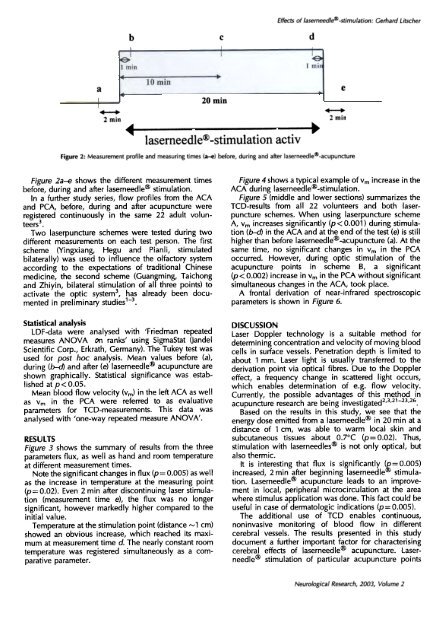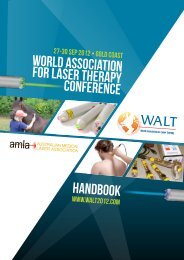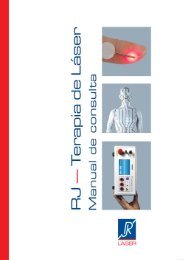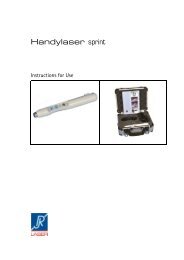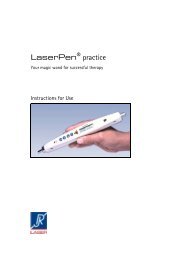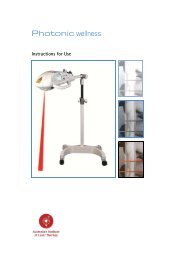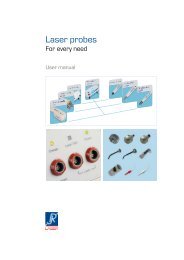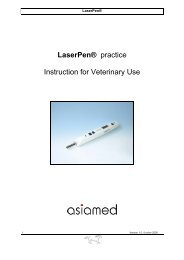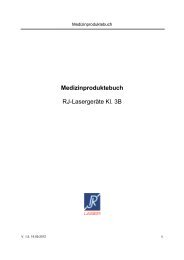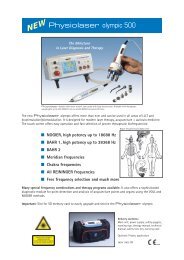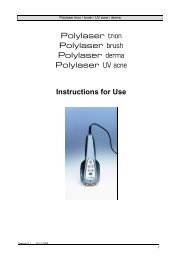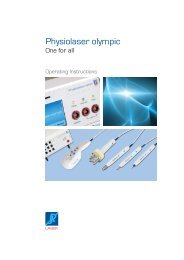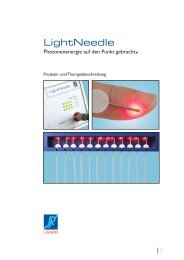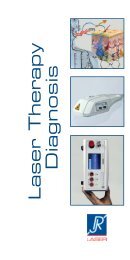LightNeedle - RJ Laser
LightNeedle - RJ Laser
LightNeedle - RJ Laser
You also want an ePaper? Increase the reach of your titles
YUMPU automatically turns print PDFs into web optimized ePapers that Google loves.
a<br />
+-+<br />
2 min<br />
b c<br />
miR<br />
10 min<br />
20 min<br />
lasemeedle@-stimulation activ<br />
Effects of laserneedle@-stimulation: Gerhard Litscher<br />
d<br />
'..e<br />
I min<br />
e<br />
-.-+ 2 min<br />
Figure 2: Measurement profile and measuring times (a-e) before, during and after laserneedle\n1-acupuncture<br />
Figure 2a-e shows the different measurement times<br />
before, during and after laserneedle@ stimulation.<br />
In a further study series, flow profiles from the ACA<br />
and P CA, before, during and after acupuncture were<br />
registered continuously in the same 22 adult volunteers3.<br />
Two laserpuncture schemes were tested during two<br />
different measurements on each test person. The first<br />
scheme (Yingxiang, Hegu and Pianli, stimulated<br />
bilaterally) was used to influence the olfactory system<br />
according to the expectations of traditional Chinese<br />
medicine, the second scheme (Guangming, Taichong<br />
and Zhiyin, bilateral stimulation of all three points) to<br />
activate the optic system3, has already been documented<br />
in preliminary studies 1-3.<br />
Statistical analysis<br />
LDF-data were analysed with 'Friedman repeated<br />
measures ANOV A on ranks' using SigmaStat Oandel<br />
Scientific Corp., Erkrath, Germany). The Tukey test was<br />
used for post hoc analysis. Mean values before (a),<br />
during (b-d) and after (e) laserneedle@ acupuncture are<br />
shown graphically. Statistical significance was estab-<br />
lished at p< 0.05.<br />
Mean blood flow velocity (vm) in the left ACA as weil<br />
as Vm in the PCA were referred to as evaluative<br />
parameters for TCD-measurements. This data was<br />
analysed with 'one-way repeated measure ANOVA'.<br />
RESULTS<br />
Figure 3 shows the summary of results from the three<br />
parameters flux, as weil as hand and room temperature<br />
at different measurement times.<br />
Note the significant changes in flux (p= 0.005) as weil<br />
as the increase in temperature at the measuring point<br />
(p= 0.02). Even 2 min after discontinuing laser stimulation<br />
(measurement time e), the flux was no longer<br />
significant, however markedly higher compared to the<br />
initial value.<br />
Temperature at the stimulation point (distance "",1 cm)<br />
showed an obvious increase, which reached its maximum<br />
at measurement time d. The nearly constant room<br />
temperature was registered simultaneously as a com-<br />
parative parameter.<br />
Figure 4 shows a typical example of Vm jncrease in the<br />
ACA during laserneedle@-stjmulation.<br />
Figure 5 (middle and lower sectjons) summarizes the<br />
TCD-results from all 22 volunteers and both laserpuncture<br />
schemes. When usjng laserpuncture scheme<br />
A, Vm increases significantly (p < 0.001) during stimulatjon<br />
(b-d) in the ACA and at the end of the test (e) is stjll<br />
higher than before laserneedle@-acupuncture (a). At the<br />
same time, no significant changes jn Vm in the PCA<br />
occurred. However, durjng optjc stjmulation of the<br />
acupuncture points jn scheme B, a signjfjcant<br />
(p< 0.002) increase in Vm in the PCA without signjficant<br />
simultaneous changes jn the ACA, took place.<br />
A frontal derivation of near-jnfrared spectroscopic<br />
parameters js shown jn Figure 6.<br />
DISCUSSION<br />
<strong>Laser</strong> Doppler technology js a suitable method for<br />
determinjng concentratjon and velocjty of moving blood<br />
cells in surface vessels. Penetratjon depth is Ijmjted to<br />
about 1 mm. <strong>Laser</strong> Ijght js usually transferred to the<br />
derivation point via optical fibres. Due to the Doppler<br />
effect, a frequency change in scattered Ijght occurs,<br />
whjch enables determination of e.g. flow velocjty.<br />
Currently, the possible advantages of this method jn<br />
acupuncture research are being investjgated2.3,21-23,26.<br />
Based on the results in this study, we see that the<br />
energy dose emjtted from a laserneedle@ jn 20 min at a<br />
distance of 1 cm, was able to warm local skin and<br />
subcutaneous tissues about 0.7°C (p= 0.02). Thus,<br />
stimulation wjth laserneedles@ is not only optical, but<br />
also thermic.<br />
It is interestjng that flux is signjficantly ~= 0.005)<br />
increased, 2 mjn after begjnnjng laserneedle stimulation.<br />
<strong>Laser</strong>needle@ acupuncture leads to an jmprovement<br />
in local, peripheral microcirculation at the area<br />
where stjmulus applicatjon was done. This fact could be<br />
useful in case of dermatologic indications (p=0.005).<br />
The additional use of TCD enables continuous,<br />
noninvasjve monitorjng of blood flow in different<br />
cerebral vessels. The results presented in this study<br />
document a further important factor for characterising<br />
cerebral effects of laserneedle@ acupuncture. laserneedle@<br />
stimulatjon of particular acupuncture points<br />
Neurological Research, 2003, Volume 2


